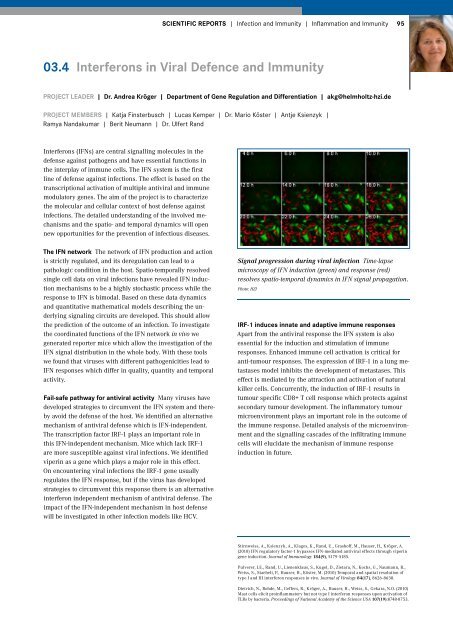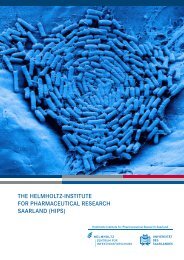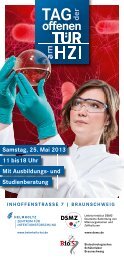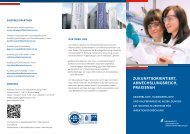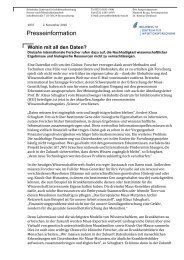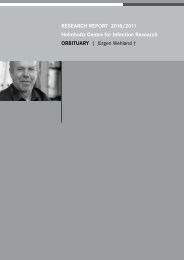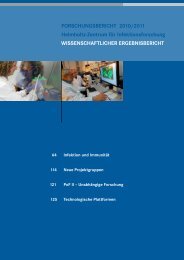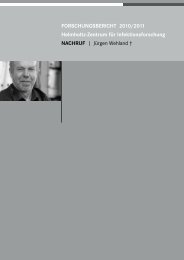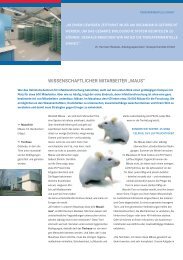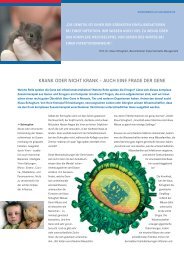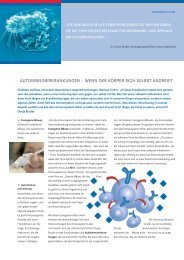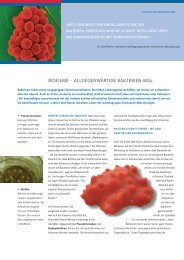Research Report 2010 2011 - Helmholtz-Zentrum für ...
Research Report 2010 2011 - Helmholtz-Zentrum für ...
Research Report 2010 2011 - Helmholtz-Zentrum für ...
Create successful ePaper yourself
Turn your PDF publications into a flip-book with our unique Google optimized e-Paper software.
SCIENTIFIC REPORTS | Infection and Immunity | Infl ammation and Immunity 95<br />
03.4 Interferons in Viral Defence and Immunity<br />
PROJECT LEADER | Dr. Andrea Kröger | Department of Gene Regulation and Differentiation | akg@helmholtz-hzi.de<br />
PROJECT MEMBERS | Katja Finsterbusch | Lucas Kemper | Dr. Mario Köster | Antje Ksienzyk |<br />
Ramya Nandakumar | Berit Neumann | Dr. Ulfert Rand<br />
Interferons (IFNs) are central signalling molecules in the<br />
defense against pathogens and have essential functions in<br />
the interplay of immune cells. The IFN system is the first<br />
line of defense against infections. The effect is based on the<br />
transcriptional activation of multiple antiviral and immune<br />
modulatory genes. The aim of the project is to characterize<br />
the molecular and cellular context of host defense against<br />
infections. The detailed understanding of the involved mechanisms<br />
and the spatio- and temporal dynamics will open<br />
new opportunities for the prevention of infectious diseases.<br />
The IFN network The network of IFN production and action<br />
is strictly regulated, and its deregulation can lead to a<br />
pathologic condition in the host. Spatio-temporally resolved<br />
single cell data on viral infections have revealed IFN induction<br />
mechanisms to be a highly stochastic process while the<br />
response to IFN is bimodal. Based on these data dynamics<br />
and quantitative mathematical models describing the underlying<br />
signaling circuits are developed. This should allow<br />
the prediction of the outcome of an infection. To investigate<br />
the coordinated functions of the IFN network in vivo we<br />
generated reporter mice which allow the investigation of the<br />
IFN signal distribution in the whole body. With these tools<br />
we found that viruses with different pathogenicities lead to<br />
IFN responses which differ in quality, quantity and temporal<br />
activity.<br />
Fail-safe pathway for antiviral activity Many viruses have<br />
developed strategies to circumvent the IFN system and thereby<br />
avoid the defense of the host. We identified an alternative<br />
mechanism of antiviral defense which is IFN-independent.<br />
The transcription factor IRF-1 plays an important role in<br />
this IFN-independent mechanism. Mice which lack IRF-1<br />
are more susceptible against viral infections. We identified<br />
viperin as a gene which plays a major role in this effect.<br />
On encountering viral infections the IRF-1 gene usually<br />
regulates the IFN response, but if the virus has developed<br />
strategies to circumvent this response there is an alternative<br />
interferon independent mechanism of antiviral defense. The<br />
impact of the IFN-independent mechanism in host defense<br />
will be investigated in other infection models like HCV.<br />
Signal progression during viral infection Time-lapse<br />
microscopy of IFN induction (green) and response (red)<br />
resolves spatio-temporal dynamics in IFN signal propagation.<br />
Photo: HZI<br />
IRF-1 induces innate and adaptive immune responses<br />
Apart from the antiviral response the IFN system is also<br />
essential for the induction and stimulation of immune<br />
responses. Enhanced immune cell activation is critical for<br />
anti-tumour responses. The expression of IRF-1 in a lung metastases<br />
model inhibits the development of metastases. This<br />
effect is mediated by the attraction and activation of natural<br />
killer cells. Concurrently, the induction of IRF-1 results in<br />
tumour specific CD8+ T cell response which protects against<br />
secondary tumour development. The inflammatory tumour<br />
microenvironment plays an important role in the outcome of<br />
the immune response. Detailed analysis of the microenvironment<br />
and the signalling cascades of the infiltrating immune<br />
cells will elucidate the mechanism of immune response<br />
induction in future.<br />
Stirnweiss, A., Ksienzyk, A., Klages, K., Rand, U., Grashoff, M., Hauser, H., Kröger, A.<br />
(<strong>2010</strong>) IFN regulatory factor-1 bypasses IFN-mediated antiviral effects through viperin<br />
gene induction. Journal of Immunology 184(9), 5179-5185.<br />
Pulverer, J.E., Rand, U., Lienenklaus, S., Kugel, D., Zietara, N., Kochs, G., Naumann, R.,<br />
Weiss, S., Staeheli, P., Hauser, H., Köster, M. (<strong>2010</strong>) Temporal and spatial resolution of<br />
type I and III interferon responses in vivo. Journal of Virology 84(17), 8626-8638.<br />
Dietrich, N., Rohde, M., Geffers, R., Kröger, A., Hauser, H., Weiss, S., Gekara, N.O. (<strong>2010</strong>)<br />
Mast cells elicit proinflammatory but not type I interferon responses upon activation of<br />
TLRs by bacteria. Proceedings of National Academy of the Science USA 107(19):8748-8753.


